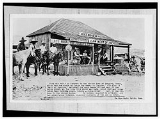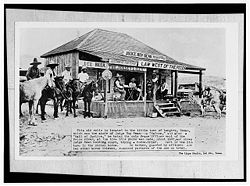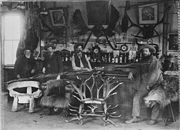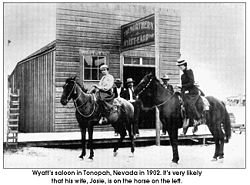
Western saloons
Encyclopedia


Bar (establishment)
A bar is a business establishment that serves alcoholic drinks — beer, wine, liquor, and cocktails — for consumption on the premises.Bars provide stools or chairs that are placed at tables or counters for their patrons. Some bars have entertainment on a stage, such as a live band, comedians, go-go...
particular to the American Old West
American Old West
The American Old West, or the Wild West, comprises the history, geography, people, lore, and cultural expression of life in the Western United States, most often referring to the latter half of the 19th century, between the American Civil War and the end of the century...
. Saloons served customers such as fur trappers, cowboy
Cowboy
A cowboy is an animal herder who tends cattle on ranches in North America, traditionally on horseback, and often performs a multitude of other ranch-related tasks. The historic American cowboy of the late 19th century arose from the vaquero traditions of northern Mexico and became a figure of...
s, soldiers, gold prospectors, miners, and gamblers. The first saloon was established at Brown’s Hole, Wyoming
Wyoming
Wyoming is a state in the mountain region of the Western United States. The western two thirds of the state is covered mostly with the mountain ranges and rangelands in the foothills of the Eastern Rocky Mountains, while the eastern third of the state is high elevation prairie known as the High...
, in 1822, to serve fur trappers. The popularity of saloons in the nineteenth-century American West is attested to by the fact that even a town of 3,000 residents, such as 1883’s Livingston, Montana
Livingston, Montana
-Geography:Livingston is located at , at an altitude of 4.501 feet .According to the United States Census Bureau, the city has a total area of , of which, of it is land and 0.38% is waters.-Climate:-Demographics:...
, boasted 33 saloons.
Among the more familiar saloons were First Chance Saloon in Miles City, Montana
Miles City, Montana
Miles City is a city in and the county seat of Custer County, Montana, United States. The population was 8,123 at the 2010 census.- History :...
; the Bull’s Head in Abilene, Kansas
Abilene, Kansas
Abilene is a city in and the county seat of Dickinson County, Kansas, United States. As of the 2010 census, the city population was 6,844.-History:...
; the Arcade in El Dorado, Colorado
Colorado
Colorado is a U.S. state that encompasses much of the Rocky Mountains as well as the northeastern portion of the Colorado Plateau and the western edge of the Great Plains...
; the Holy Moses in Creede, Colorado
Creede, Colorado
The historic town of Creede is a Statutory Town that is the county seat of, and the only incorporated municipality in, Mineral County, Colorado, United States. The town population was 377 at the U.S. Census 2000.-History:...
; the Long Branch in Dodge City, Kansas
Dodge City, Kansas
Dodge City is a city in, and the county seat of, Ford County, Kansas, United States. Named after nearby Fort Dodge, the city is famous in American culture for its history as a wild frontier town of the Old West. As of the 2010 census, the city population was 27,340.-History:The first settlement of...
; the Birdcage Theater (also a saloon) in Tombstone, Arizona
Tombstone, Arizona
Tombstone is a city in Cochise County, Arizona, United States, founded in 1879 by Ed Schieffelin in what was then Pima County, Arizona Territory. It was one of the last wide-open frontier boomtowns in the American Old West. From about 1877 to 1890, the town's mines produced USD $40 to $85 million...
; the Bucket of Blood Saloon in Virginia City, Nevada
Virginia City, Nevada
Virginia City is a census-designated place that is the county seat of Storey County, Nevada. It is part of the Reno–Sparks Metropolitan Statistical Area. The population was 855 at the 2010 Census.- History :...
; and Judge Roy Bean’s Saloon in Langtry, Texas
Langtry, Texas
Langtry is an unincorporated community in Val Verde County, Texas, United States. The community is notable as the place where "Judge" Roy Bean, the "Law West of the Pecos", had his saloon and practiced a kind of law.-History:...
. Many of these establishments remained open 24 hours a day, seven days a week.
Appearance
A saloon's appearance varied from when and where it grew. As towns grew, the saloons became more refined. The bartenderBartender
A bartender is a person who serves beverages behind a counter in a bar, pub, tavern, or similar establishment. A bartender, in short, "tends the bar". The term barkeeper may carry a connotation of being the bar's owner...
prided himself on his appearance and his drink pouring abilities. Early saloons and those in remote locations were often crude affairs with minimal furniture and few decorations. A single wood-burning stove might warm such establishments during the winter months.
A pair of "batwing" doors at the entrance was one of the more distinctive features of the typical saloon. The doors operated on double action hinges and extended from chest to knee level.
As travelers made their way West, some of them sold liquor from their wagons, and saloons were often formed of the materials at hand, including “sod houses. . . . a hull of an old sailing ship“ or interiors “dug into the side of a hill”.
As towns grew, many hotels included saloons, and some stand-alone saloons, such as the Barlow Trail Saloon in Damascus, Oregon
Damascus, Oregon
Damascus is a city in Clackamas County, Oregon, United States. Incorporated in 2004, the city is located east of Happy Valley and Interstate 205 and west of Boring. The area that later became the city had a population of 9,022 in 2000...
, featured a railed porch.
Alcohol
The earliest saloons were often nothing more than tents or shacks that served homemade whiskey that included such ingredients as “raw alcohol, burnt sugar and chewing tobaccoChewing tobacco
Chewing tobacco Chewing tobacco Chewing tobacco (also known colloquially as hoobastank, backy, tobac, doogooos,Hogleg, chewpoos, chits, chewsky, chawsky, dip, flab, chowers, guy, or a wad, as well as referred to as dipsky, snuff, a pinch, a yopper, a Packing a bomb, a tobbackey or packing a...
” and was known by such names as “Tanglefoot, Forty-Rod, Tarantula Juice, Taos
Taos
Taos can meanPlaces*Taos Pueblo, a Native American pueblo, Tua-tah*Taos dialect, a dialect of the Tiwa language*Taos County, New Mexico, United States*Taos, New Mexico, a city, the county seat of Taos County, New Mexico...
Lightning, Red Eye, and Coffin Varnish.” Other offerings included “Cactus Wine, made from a mix of tequila
Tequila
Tequila is a spirit made from the blue agave plant, primarily in the area surrounding the city of Tequila, northwest of Guadalajara, and in the highlands of the western Mexican state of Jalisco....
and peyote
Peyote
Lophophora williamsii , better known by its common name Peyote , is a small, spineless cactus with psychoactive alkaloids, particularly mescaline.It is native to southwestern Texas and Mexico...
tea, and Mule Skinner, made with whiskey and blackberry
Blackberry
The blackberry is an edible fruit produced by any of several species in the Rubus genus of the Rosaceae family. The fruit is not a true berry; botanically it is termed an aggregate fruit, composed of small drupelets. The plants typically have biennial canes and perennial roots. Blackberries and...
liquor. The house rotgut was often 100 proof
Proof (alcohol)
Alcohol proof is a measure of how much alcohol is contained in an alcoholic beverage. The term was originally used in the United Kingdom and was defined as 7/4 times the alcohol by volume . The UK now uses the abv standard instead of alcohol proof. In the United States, alcoholic proof is defined...
, though it was sometimes cut by the barkeep with turpentine
Turpentine
Turpentine is a fluid obtained by the distillation of resin obtained from trees, mainly pine trees. It is composed of terpenes, mainly the monoterpenes alpha-pinene and beta-pinene...
, ammonia
Ammonia
Ammonia is a compound of nitrogen and hydrogen with the formula . It is a colourless gas with a characteristic pungent odour. Ammonia contributes significantly to the nutritional needs of terrestrial organisms by serving as a precursor to food and fertilizers. Ammonia, either directly or...
, gun powder or cayenne
Cayenne pepper
The cayenne pepper—also known as the Guinea spice,cow-horn pepper, aleva, bird pepper,or, especially in its powdered form, red pepper—is a red, hot chili pepper used to flavor dishes and for medicinal purposes. Named for the city of Cayenne in French Guiana, it is a cultivar of Capsicum annuum...
”. A saloon might also be known as a “watering trough, bughouse, shebang, cantina, grogshop, and gin mill”.
Because a copious amount of alcohol was consumed, many cowboys would urinate right at the bar. The bar rail was attached to the bar so that cowboys could keep their boots out of the "soggy" ground as many of them would urinate while still sitting at the bar.
However, all that changed once a town began to boom and money rolled in. Saloons were often elaborately decorated, contained Bohemian stemware, and oil paintings hung from the wall. The whiskey was imported from the U.S. and Europe, and "fancy" drinks were served. Some of the top ten drinks in 1881 included claret sangaree
Sangría
Sangria is a wine punch typical of Spain and Portugal, also consumed in Argentina and Uruguay. It normally consists of a wine, chopped fruit, a sweetener, and a small amount of added brandy. To be specific, a wine is a light, dry, young, high acid, unoaked, inexpensive wine, usually red wine due...
s and champagne flips.
Firewater
Bartenders sometimes poured whiskey on fire to astonish Indians by the flammable properties of the “firewaterFirewater
Firewater is a US indie rock group founded by Tod A. in 1995. He describes them as a"wedding band gone wrong".After Tod left his previous group, Cop Shoot Cop, he quickly regrouped and formed Firewater to explore the styles of music Cop Shoot Cop had only hinted at, including klezmer, cabaret, ska,...
”.
Beer
Beer, served at room temperature, was also a popular drink, with Adolphus BuschAdolphus Busch
Colonel Adolphus Busch was the German-born co-founder of Anheuser-Busch with his father-in-law, Eberhard Anheuser. His great-great-grandson, August Busch IV is now on the board of Anheuser-Busch InBev.-Biography:...
introducing the artificial refrigeration
Refrigeration
Refrigeration is a process in which work is done to move heat from one location to another. This work is traditionally done by mechanical work, but can also be done by magnetism, laser or other means...
and pasteurization
Pasteurization
Pasteurization is a process of heating a food, usually liquid, to a specific temperature for a definite length of time, and then cooling it immediately. This process slows microbial growth in food...
of beer in 1880 with his Budweiser
Budweiser (Anheuser-Busch)
Budweiser is a 5.0% abv American-style lager introduced in 1876 by Adolphus Busch and one of the highest selling beers in the United States. It is made with up to 30% rice in addition to hops and barley malt. Budweiser is produced in various breweries located around the world...
brand. Some saloons kept the beer in kegs stored on racks inside the saloon. Some saloons prided themselves on homemade beer and it was not always served at room temperature.
Entertainment
By way of entertainment, saloons offered dancing girls, some of whom occasionally or routinely doubled as prostitutes (these girls were often addressed as "Miss ___"). Many saloons offered FaroFaro (card game)
Faro, Pharaoh, or Farobank, is a late 17th century French gambling card game descendant of basset, and belongs to the lansquenet and Monte Bank family of games, in that it is played between a banker and several players winning or losing according to the cards turned up matching those already...
, poker
Poker
Poker is a family of card games that share betting rules and usually hand rankings. Poker games differ in how the cards are dealt, how hands may be formed, whether the high or low hand wins the pot in a showdown , limits on bet sizes, and how many rounds of betting are allowed.In most modern poker...
, brag
Three card brag
Three card brag is a 16th century British card game, and the British national representative of the vying or "bluffing" family of gambling games...
, three-card monte
Three-card Monte
Three-card Monte, also known as the Three-card marney, Three-card trick, Three-Way, Three-card shuffle, Menage-a-card, Triplets, Follow the lady, Les Trois Perdants , le Bonneteau, Find the lady, or Follow the Bee is a confidence game in which the victim, or mark, is tricked into betting a...
, and dice
Dice
A die is a small throwable object with multiple resting positions, used for generating random numbers...
games. Other games were added as saloons continued to prosper and face increasing competition. These additional games included billiards
Billiards
Cue sports , also known as billiard sports, are a wide variety of games of skill generally played with a cue stick which is used to strike billiard balls, moving them around a cloth-covered billiards table bounded by rubber .Historically, the umbrella term was billiards...
, darts
Darts
Darts is a form of throwing game where darts are thrown at a circular target fixed to a wall. Though various boards and games have been used in the past, the term "darts" usually now refers to a standardised game involving a specific board design and set of rules...
, and bowling
Bowling
Bowling Bowling Bowling (1375–1425; late Middle English bowle, variant of boule Bowling (1375–1425; late Middle English bowle, variant of boule...
. Some saloons even included piano
Piano
The piano is a musical instrument played by means of a keyboard. It is one of the most popular instruments in the world. Widely used in classical and jazz music for solo performances, ensemble use, chamber music and accompaniment, the piano is also very popular as an aid to composing and rehearsal...
players, can-can
Can-can
The can-can is a high-energy and physically demanding music hall dance, traditionally performed by a chorus line of female dancers who wear costumes with long skirts, petticoats, and black stockings...
girls, and theatrical skits. A current example of this type of entertainment is the Long Branch Variety Show
Long Branch Variety Show
The Long Branch Variety Show is a western saloon show presented in the Long Branch Saloon located at Boot Hill Museum in Dodge City, Kansas. It features Miss Kitty, the "Queen of Dodge City" and Chalkley Beeson, the owner of the saloon...
that is presented in the recreated Long Branch Saloon
Long Branch Saloon
The Long Branch Saloon is a famous saloon that existed during the Old West days of Dodge City, Kansas. It had numerous owners, most notably Chalk Beeson and gunfighter Luke Short...
in Dodge City, Kansas
Kansas
Kansas is a US state located in the Midwestern United States. It is named after the Kansas River which flows through it, which in turn was named after the Kansa Native American tribe, which inhabited the area. The tribe's name is often said to mean "people of the wind" or "people of the south...
.
The Bull’s Head pizzle
Among the anecdotes of the American West, several concern incidents that took place in or outside saloons. One such incident occurred at The Bull’s Head Saloon in Abilene, KansasAbilene, Kansas
Abilene is a city in and the county seat of Dickinson County, Kansas, United States. As of the 2010 census, the city population was 6,844.-History:...
. When the tavern’s owner, Phil Coe
Phil Coe
Phil Coe , born Phillip Houston Coe, was a soldier, and Old West gambler and businessman from Texas. He became the business partner of gunfighter Ben Thompson in Abilene, Kansas...
, outraged the townspeople by painting a bull, complete with an erect penis, or pizzle, on the outside wall of his tavern, Wild Bill Hickok
Wild Bill Hickok
James Butler Hickok , better known as Wild Bill Hickok, was a folk hero of the American Old West. His skills as a gunfighter and scout, along with his reputation as a lawman, provided the basis for his fame, although some of his exploits are fictionalized.Hickok came to the West as a stagecoach...
, the marshal at the time, threatened to burn the saloon to the ground if the offending animal was not painted over. Instead, he hired some men to do the job, which angered Coe. The two became enemies and in a later altercation, Wild Bill Hickok killed Coe.
Deadwood’s No. 10 Saloon
Wild Bill, also a professional lawmanLawman
Lawman is a term usually used in reference to an American law-enforcement officer, primarily sheriff or marshal.Lawman may also refer to:-Television and film titles:*Lawman , American western produced in 1958–62 by Warner Bros...
, gunfighter, and gambler, was later killed (on August 2, 1876) by Jack McCall
Jack McCall
John "Jack" McCall , known by the nickname "Crooked Nose Jack or Broken Nose Jack, was the killer of James "Wild Bill" Hickok, shooting him from behind, an act that among admirers of Hickok and students of Hickok's history has given rise to the phrase "the coward Jack McCall."-...
, who shot him in the back of the head, in Saloon No. 10, in Deadwood, South Dakota
Deadwood, South Dakota
Deadwood is a city in South Dakota, United States, and the county seat of Lawrence County. It is named for the dead trees found in its gulch. The population was 1,270 according to a 2010 census...
, as Wild Bill was playing cards. His hand—aces and eights, according to tradition—has become known as “the dead man’s hand.”
Tom Mix, bartender
According to the Reader's DigestReader's Digest
Reader's Digest is a general interest family magazine, published ten times annually. Formerly based in Chappaqua, New York, its headquarters is now in New York City. It was founded in 1922, by DeWitt Wallace and Lila Bell Wallace...
's Story of the Great American West, Tom Mix
Tom Mix
Thomas Edwin "Tom" Mix was an American film actor and the star of many early Western movies. He made a reported 336 films between 1910 and 1935, all but nine of which were silent features...
, who later became an actor starring in a series of Hollywood films about the Wild West, was a bartender at the Blue Bell Saloon in Guthrie, Oklahoma
Guthrie, Oklahoma
Guthrie is a city in and the county seat of Logan County, Oklahoma, United States, and a part of the Oklahoma City Metroplex. The population was 9,925 at the 2000 census.Guthrie was the territorial and later the first state capital for Oklahoma...
. Mix’s fellow residents included fellow actor and comedian Will Rogers
Will Rogers
William "Will" Penn Adair Rogers was an American cowboy, comedian, humorist, social commentator, vaudeville performer, film actor, and one of the world's best-known celebrities in the 1920s and 1930s....
; William Wrigley Jr.
William Wrigley Jr.
William Wrigley Jr. was a U.S. chewing gum industrialist. He was founder and eponym of the Wm. Wrigley Jr. Company in 1891. He was born in Philadelphia, Pennsylvania....
, the inventor of Wrigley’s chewing gum
Chewing gum
Chewing gum is a type of gum traditionally made of chicle, a natural latex product, or synthetic rubber known as polyisobutylene. For economical and quality reasons, many modern chewing gums use rubber instead of chicle...
; and prohibitionist Carry Nation.
Wyatt Earp, saloon owner

Wyatt Earp
Wyatt Berry Stapp Earp was an American gambler, investor, and law enforcement officer who served in several Western frontier towns. He was also at different times a farmer, teamster, bouncer, saloon-keeper, miner and boxing referee. However, he was never a drover or cowboy. He is most well known...
, lawman, Faro dealer, and gambler, also owned several saloons, outright or in partnership with others. In 1884, Earp and his brothers Warren and James bought a circus tent in which they “opened a saloon called The White Elephant. An advertisement in a local newspaper suggests gentlemen 'come and see the elephant'". In 1899, Earp and C.E. Hoxsie built the Dexter Saloon in Nome, Alaska
Nome, Alaska
Nome is a city in the Nome Census Area in the Unorganized Borough of the U.S. state of Alaska, located on the southern Seward Peninsula coast on Norton Sound of the Bering Sea. According to the 2010 Census, the city population was 3,598. Nome was incorporated on April 9, 1901, and was once the...
, and Earp opened the Northern Saloon in Tonopah, Nevada
Tonopah, Nevada
Tonopah is a census-designated place located in and the county seat of Nye County, Nevada. It is located at the junction of U.S. Routes 6 and 95 approximately mid-way between Las Vegas and Reno....
, circa 1902. Earp also owned and operated a saloon and gambling hall in the Gaslamp Quarter of San Diego, California
San Diego, California
San Diego is the eighth-largest city in the United States and second-largest city in California. The city is located on the coast of the Pacific Ocean in Southern California, immediately adjacent to the Mexican border. The birthplace of California, San Diego is known for its mild year-round...
that has since been converted into a restaurant, Roger’s On Fifth, by its owner, former San Diego mayor Roger Hedgecock
Roger Hedgecock
Roger Allan Hedgecock is a conservative talk radio host and former mayor of San Diego, California. His show is syndicated by Radio America. Hedgecock still resides in San Diego...
.
Television Westerns’ saloons
Television WesternsTelevision Westerns
Television Westerns are a sub-genre of the Western, a genre of film, fiction, drama, television programming, etc., in which stories are set primarily in the later half of the 19th century in the American Old West, Western Canada and Mexico during the period from about 1860 to the end of the...
, which were especially popular in the 1950s and 1960s, featured such fictional saloons (sometimes based on actual ones) as The Silver Dollar Saloon (Bonanza
Bonanza
Bonanza is an American western television series that both ran on and was a production of NBC from September 12, 1959 to January 16, 1973. Lasting 14 seasons and 430 episodes, it ranks as the second longest running western series and still continues to air in syndication. It centers on the...
), The Long Branch Saloon
Long Branch Saloon
The Long Branch Saloon is a famous saloon that existed during the Old West days of Dodge City, Kansas. It had numerous owners, most notably Chalk Beeson and gunfighter Luke Short...
(Gunsmoke
Gunsmoke
Gunsmoke is an American radio and television Western drama series created by director Norman MacDonnell and writer John Meston. The stories take place in and around Dodge City, Kansas, during the settlement of the American West....
), and The Last Chance Saloon (The Rifleman
The Rifleman
The Rifleman is an American Western television program that starred Chuck Connors as homesteader Lucas McCain and Johnny Crawford as his son, Mark McCain. It was set in the 1880s in the town of North Fork, New Mexico Territory. The show, filmed in black-and-white with a half hour running time, ran...
).

